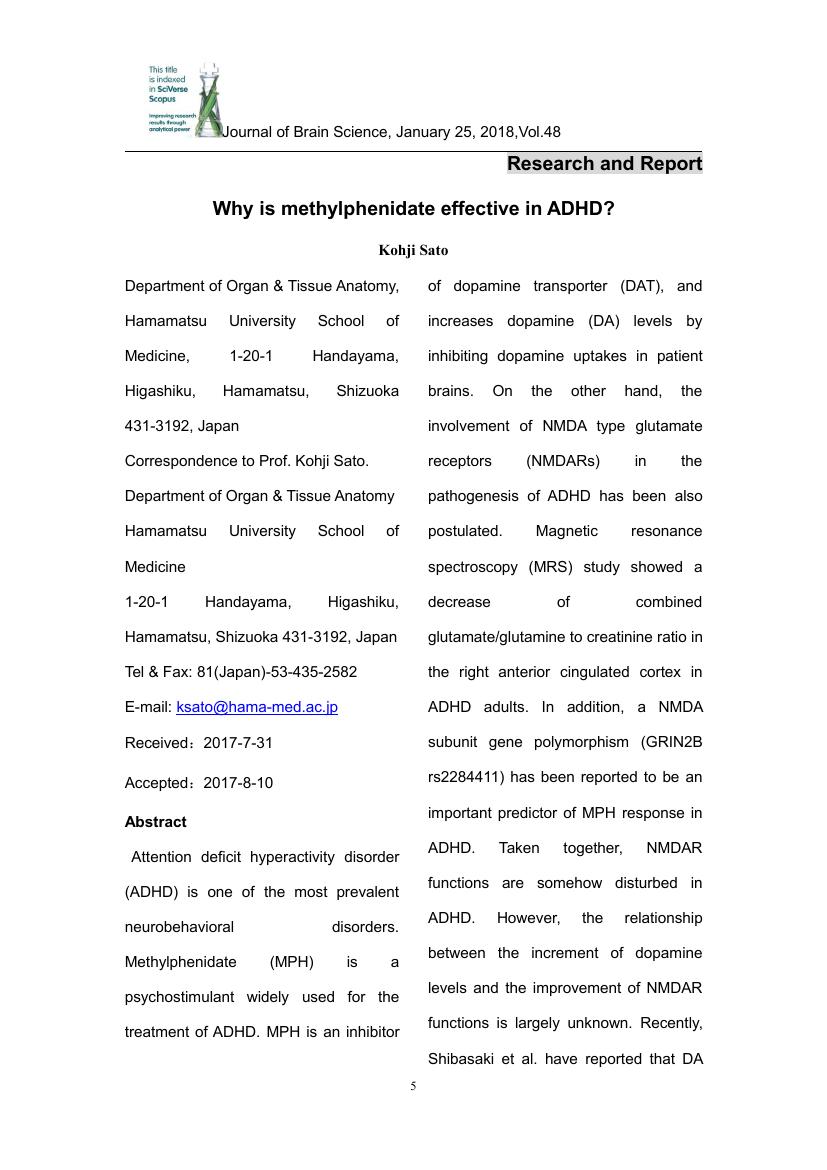2 0 0 0 OA Why is methylphenidate effective in ADHD?
- 著者
- Kohji Sato
- 出版者
- Japan Brain Science society
- 雑誌
- 脳科学誌 (ISSN:13415301)
- 巻号頁・発行日
- vol.48, pp.5-13, 2018 (Released:2018-04-16)
- 参考文献数
- 29
- 著者
- KOHJI SATO
- 出版者
- Japan Brain Science society
- 雑誌
- 脳科学誌 (ISSN:13415301)
- 巻号頁・発行日
- vol.50, pp.136-147, 2021 (Released:2022-01-18)
- 参考文献数
- 16
1 0 0 0 OA Ghrelin signaling attenuates the inflammatory activation of neuroimmune system in senescence.
- 著者
- Kojiro Endo Hiroyuki Morimoto Hayato Asai Million Hong Haruka Amitani Akihiro Asakawa Sumiko Mikawa Kohji Sato Yoshino Ueki Koichi Inoue Takatoshi Ueki Hideki Okamoto Takanobu Otsuka Hideki Murakami
- 出版者
- Japan Brain Science society
- 雑誌
- 脳科学誌 (ISSN:13415301)
- 巻号頁・発行日
- vol.49, pp.63-84, 2020 (Released:2020-12-01)
- 参考文献数
- 22
- 著者
- Shigeyuki Yamamoto Taiichi Katayama Kohji Sato
- 出版者
- Japan Brain Science society
- 雑誌
- 脳科学誌 (ISSN:13415301)
- 巻号頁・発行日
- vol.50, pp.5-30, 2021 (Released:2022-01-13)
- 参考文献数
- 39
- 著者
- Gandhervin Kesavamoorthy Sumiko Mikawa Yuya Kusakawa Tomonori Sato Michihito Miyagi Satoru Yamagishi Kohji Sato
- 出版者
- Japan Brain Science society
- 雑誌
- 脳科学誌 (ISSN:13415301)
- 巻号頁・発行日
- vol.46, pp.70-83, 2016 (Released:2017-05-09)
- 参考文献数
- 21
1 0 0 0 OA Bone Morphogenetic Protein Receptor IA and IB expression in the adult rat trigeminal nuclei
- 著者
- Yutaro Hayashi Sumiko Mikawa Kazuma Masumoto Fuminori Katou Kohji Sato
- 出版者
- Japan Brain Science society
- 雑誌
- 脳科学誌 (ISSN:13415301)
- 巻号頁・発行日
- vol.47, pp.5-20, 2017 (Released:2017-11-01)
- 参考文献数
- 18
- 著者
- Kohji Sato
- 出版者
- Japan Brain Science society
- 雑誌
- 脳科学誌 (ISSN:13415301)
- 巻号頁・発行日
- vol.46, pp.20-33, 2016 (Released:2017-05-09)
- 参考文献数
- 27
- 著者
- Kohji Sato
- 出版者
- Japan Brain Science society
- 雑誌
- 脳科学誌 (ISSN:13415301)
- 巻号頁・発行日
- vol.43, pp.24-42, 2014-05-30 (Released:2017-06-01)
Autism is a pervasive developmental disorder that is characterized by the behavioral traits of impaired social cognition and communication, and repetitive and/or obsessive behavior and interests. Although there are many theories and speculations about the pathogenetic causes of autism, the aberration of the serotonergic system is one of the most consistent and well-replicated findings. Recently, Bonnin et al. have reported that placenta-derived serotonin is the main source in embryonic day (E) 10-15 mouse forebrain, after that period, the serotonergic fibers start to supply serotonin into the forebrain. E10-15 is the pivotal developing period, when cortical neurogenesis, migration and initial axon targeting are processed. Since all these events have been considered to be involved in the pathogenesis of autism and they are highly controlled by serotonin signals, the increase of placenta-derived serotonin should have potential importance when the pathogenesis of autism is considered. I, thus, postulate a hypothesis that placenta-derived hyper-serotonin situations in the developing forebrain cause autism. The hypothesis is as follows. Various factors, such as inflammation, dysfunction of the placenta, together with genetic predispositions cause the increase of placenta-derived serotonin levels. The increase of placenta-derived serotonin levels leads to hyper-serotonin situations in the forebrain of the fetus. The increase of serotonin in the forebrain leads to mis-wiring in important regions that are responsible for the theory of mind. The increase of serotonin in the forebrain also reduces serotonergic fibers and increase microglia. These disturbances result in further network deficiency, leading to the autistic phenotypes.






